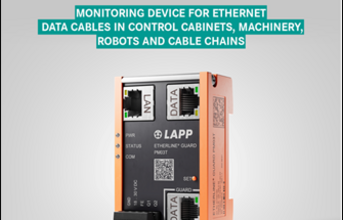
LAPP, a leader in cable and connection technology, has announced the launch of ETHERLINE® GUARD in key markets globally, including India. ETHERLINE® GUARD is a stationary monitoring device that continuously monitors an Ethernet cable, detects a decline in performance and displays it with the cable status. This is the latest addition to LAPP's extensive industrial communication portfolio.
Using the power of preventive maintenance, this device helps increase plant availability through planned machine downtimes, thereby reducing maintenance costs. ETHERLINE® GUARD allows for easy commissioning with automated parameterisation and does not require a new data cable or changes to the cable design. This enables upgrading within the existing network structure possible at any time. This device is slightly smaller than a standard deck of cards (49 mm wide, 76.5 mm high and 36 mm deep). It is operated with 24 V DC and is intended for a temperature range of -40°C to +75°C. The device is resistant to vibrations and shock by DIN EN 60529. It can be installed at the end of the communication cable, which is part of a drag chain or robotic arm. The ETHERLINE® GUARD is suitable for mounting top-hat rails and can be used for control cabinets owing to its protection class IP 20. Its unique and compact design saves space and offers reliable cloud communication, owing to the MQTT interface (for status/data evaluation, settings, Wi-Fi configuration, updating, etc.). The product is currently available in cable-bound LAN version "PM03T" and wireless Wi-Fi version PM02TWA.
In terms of applications, ETHERLINE® GUARD can be used in Ethernet-based networks for automation technology, monitoring the service life of a data cable and predicting potential failure. This device is beneficial for data cables exposed to constant mechanical stress, including movement at high speed and acceleration, changing motion sequences, rotations with very high axial rotation angles, short cycle times and small bending radii. The device can also be used in critical processes, where downtime would result in high costs or lost productivity.



























